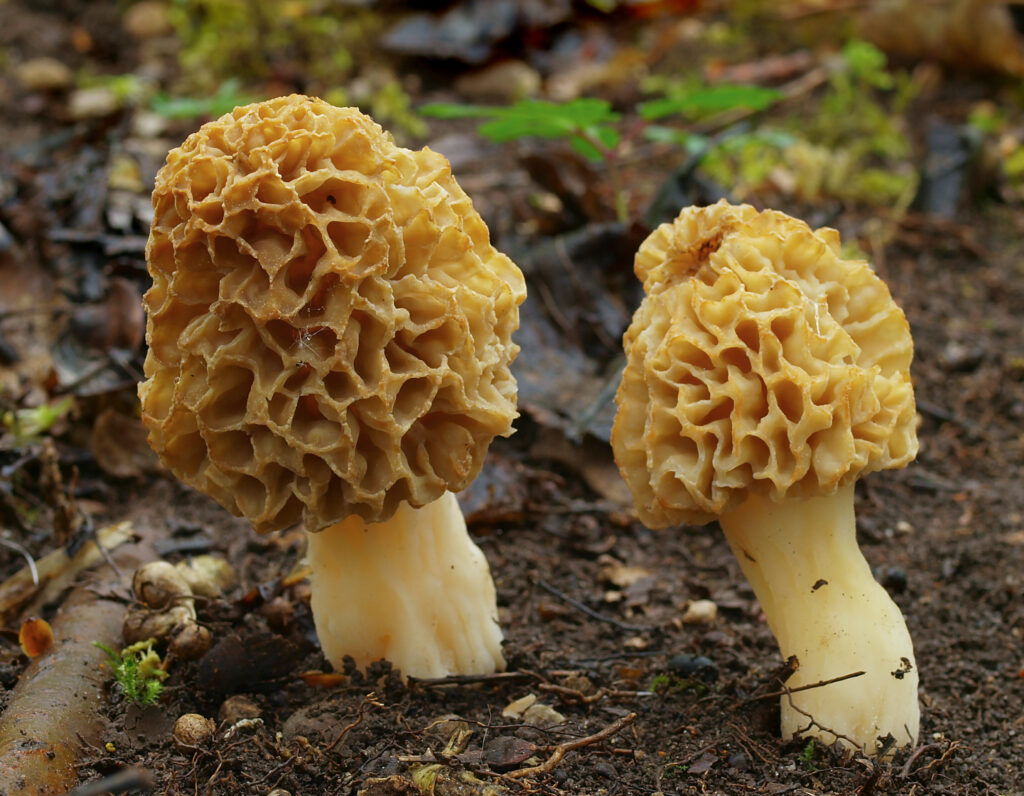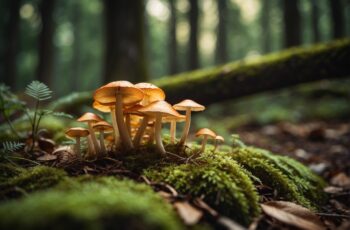Venturing into the woods during the springtime, you might be lucky enough to stumble upon a treasure sought by many an outdoorsman: baby morel mushrooms. These small, yet distinctive fungi are a delight for the mushroom hunter, both for their unique honeycomb appearance and their renowned flavor. Morels, particularly in their juvenile stage, command attention owing to their rarity and the culinary prestige they hold.

Foraging for baby morels can be a rewarding experience, but it demands patience, respect for the environment, and a keen eye. These mushrooms can be elusive, often blending in with the forest floor amidst leaves and deadwood. Familiarizing yourself with their preferred habitats—such as areas with moist soil, near decaying trees, or places recovering from recent fires—is crucial. Remember, since morels can be similar in appearance to some toxic species, it’s important to know what you’re looking for before you begin your hunt.
In this article, you’ll learn about the characteristics of baby morel mushrooms, the best practices for foraging them responsibly, and why mushroom hunters eagerly anticipate the brief season when morels make their appearance. Whether you’re a seasoned forager or just starting out, understanding the life cycle and growth conditions of morels will enhance your search and help ensure that your foraging efforts are both successful and sustainable.
Identifying Baby Morel Mushrooms

In the world of foraging, correctly identifying baby morel mushrooms is crucial for both safety and culinary enjoyment. This section will equip you with the knowledge to distinguish between true and false morels and describe the characteristics of edible morels to help you in your foraging pursuits.
True Morel Vs. False Morel
True Morels are a prize find for any forager. What sets them apart is their completely hollow interior, from the cap down to the base of the stem. When you slice a true morel vertically, you’ll find one unified cavity. True morels exhibit caps that are honeycomb-like in appearance, with pits and ridges. This feature can be your confident calling card when identifying these choice edibles.
Conversely, False Morels are not hollow, often displaying a cottony or fibrous interior rather than the single hollow chamber of their edible counterparts. False morels may have irregular or lobed caps, and they can potentially harbor toxins. It’s crucial to your safety that you learn to recognize and avoid these deceivers.
Characteristics Of Edible Morels
Edible morels have a few distinct traits that set them apart, making your search both successful and satisfying. Here’s what to look out for:
- Cap: Baby morels feature a small but distinct conical cap, often resembling a pinecone or a honeycomb, marked with a network of ridges and valleys. The cap should be attached directly to the top of the stem.
- Stem: A true morel’s stem is typically white to pale yellow, thickening slightly as the mushroom matures. Remember, in young morels, like Half-Free Morels, the stem attaches to the cap halfway up the interior of the cap, making it seem like the cap is perched on the stalk.
- Color: Ranging from pale cream to a darker brown, the color can provide clues but shouldn’t be the sole factor for identification, as it may vary.
In your pursuit of these springtime delicacies, pay close attention to these features to ensure a safe and rewarding forage. Happy hunting!
Habitat and Growing Conditions

When you set out to cultivate or forage baby morel mushrooms, understanding the specific habitat and growing conditions they require is crucial to your success.
Ideal Soil and Weather
Morel mushrooms thrive in well-drained, loamy soil that is rich in organic matter. Their development is significantly influenced by weather conditions; they favor a specific soil temperature range of 45°F – 50°F. This typically occurs in early spring, post snowmelt and prior to the intense heat of late spring and summer. You want soil that can retain moisture without becoming waterlogged—think alongside rivulets or in woods that offer a mix of sun and shade.
Symbiotic Relationships
A key to morel proliferation is their mycorrhizal relationships, particularly with hardwood trees like elms and oaks. This symbiosis allows for an exchange of nutrients crucial to both parties. Morels are especially common in North America, often found in woods that have experienced fire or those with decaying hardwood to tap into.
Common Habitats in North America
In North America, your best bets for discovering or creating a habitat for morels are:
- Deciduous hardwood forests, as they offer the mycorrhizal networks that morels form with trees,
- Burn sites, where recent fires have cleared out old growth, making room for morels to flourish,
- Orchards and old fields, which can mimic the disturbed areas morels are drawn to due to the turnover of soil and organic debris.
It’s important to note that morels are elusive and their fruiting can be as much about the right conditions as it is about timing in the season. Keep your eye out for these habitats and you may just find yourself with a bountiful harvest.
Harvesting and Culinary Use
In the world of edible mushrooms, morels stand out for their unique flavor and highly anticipated spring arrival. Harvesting morels requires both skill and respect for their natural environment, and turning them into a culinary delight is a satisfying reward for your foraging efforts.
Best Practices for Foragers
When you’re foraging for morels in the spring, look for areas where the soil is moist and there’s dappled light—common conditions in the woodlands of Canada and other parts of North America. To sustainably harvest morels and help ensure future growth, cut the stems above the soil with a sharp knife and leave the base intact. This practice encourages the spores to be released and gives rise to the next season’s crop.
Cleaning and Preparation
After a successful forage, gently clean your morels by rinsing them in cool water to remove any dirt or debris. Avoid soaking them, as they are like sponges and will absorb excess water. To prepare them for cooking or preservation, consider blanching the morels in boiling water for 2-3 minutes, then transfer them to an ice bath. This helps maintain their firm texture.
- Blanching: 2-3 minutes in boiling water, then ice bath
- Drying: Pat dry and arrange in a single layer for freezing or use immediately
Popular Morel Recipes
The intricate flavors of morels make them perfect for a variety of dishes. Here are three classic ways to enjoy your harvest in the kitchen:
- Morel Sauce: Sauté morels in butter and garlic, then simmer with cream for a luxurious sauce that pairs beautifully with steak or pasta.
- Morel Soup: Combine chopped morels with a rich broth, onions, and herbs for a warming spring soup that highlights the mushroom’s earthy tones.
- Sautéed Morels: Simply sauté whole or sliced morels in butter until golden brown—a delicious way to let their natural flavors shine.
By following these tips on harvesting, cleaning, and cooking morels, you’ll make the most out of these coveted springtime treasures. Happy foraging and enjoy the fruits of your hunt with these tasty recipes!
Cultivation and Challenges

As an enthusiast looking to cultivate baby morel mushrooms, you need to understand the meticulous process and the hurdles you might face. These fungi are known for their distinct taste and are a forager’s delight, but when it comes to growing them at your place, whether it’s the Black Morel or the Common Morel, the task can demand a great deal of expertise.
Domestic Cultivation Techniques
When you’re gearing up to grow baby morel mushrooms at home, you’ll need to mimic their natural conditions as closely as possible. Begin by choosing a spot that’s moist and well-shaded, replicating the forest floor they thrive on. Indoor cultivation provides you with controlled conditions, but remember, morels are fond of the great outdoors. You can use a mix of peat moss and compost to prepare your substrate, ensuring it remains damp and nourishing for your morels. The beds should be well-aerated and maintained at a consistent temperature, closely shadowing their spring-like habitat preferences.
- Substrate mixture: Peat moss (60%) + Compost (40%)
- Temperature: Keep soil around 45°F to 60°F
- Humidity: Maintain high moisture levels
Challenges and Expertise Needed
The path of growing morel mushrooms is filled with challenges as these fungi are classified as difficult to cultivate. Even experienced growers may find themselves at odds with the capricious nature of morels. They require specific soil pH levels (slightly alkaline) and precise temperature controls, both of which can be hard to maintain. Unlike other mushroom varieties, morels also have a unique symbiotic relationship with trees, which is a complex factor to replicate in a home setting. Be aware of the poisonous look-alike, Gyromitra, which can easily be mistaken for morels by the untrained eye. Your expertise in distinguishing and understanding morel mushrooms’ life cycle and environmental needs plays a crucial role in successful cultivation.
- Soil pH: Aim between 7.0 to 8.0
- Symbiosis: Difficult replication of tree-fungi relationship
- Gyromitra: Careful identification to avoid toxic variants
Armed with patience and precision, you can embark on this challenging but rewarding journey of cultivating morel mushrooms. There’s no better feeling than watching your very own morel mushrooms peek out from your well-crafted beds, ready for a savory delight.


